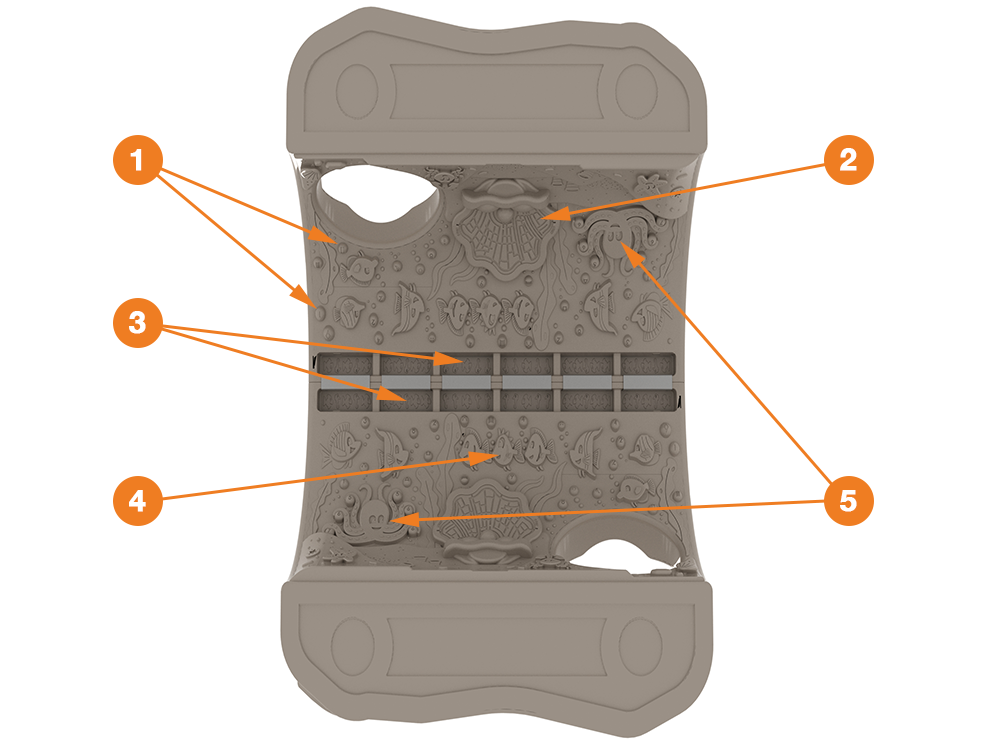Poseidon's Hideout Educational Guide

1. Number Games:
There are tons of three-dimensional bubbles scattered throughout the nautical scene, which have numbers, shapes, and symbols printed on them. These provide plenty of opportunities for educational gameplay.
• Try to count every bubble they can find.
• Find each of the numbered bubbles in order, counting as high as possible.
• Pick a shape bubble, then find the number bubble which represents the number of shapes, or the number of sides.
• Finding all of the odd or even numbered bubbles.
• Add two of the numbers in smaller bubbles together, then try to find a bubble that contains their sum.
• The number of suction cups on each of the octopus’ tentacles matches the number in the bubble that tentacle is holding. Children can count the suction cups, then check to see if they got the right answer.
2. Clam Maze:
The lines on the open clamshell are actually a detailed maze with entrances on both the left and right sides. The mazes’ paths are imprinted into the wall, which allows children to easily trace them with a finger to avoid losing their place. Both sides of the maze are different, which makes it more like two mazes in one. Children can try to complete both of them, or have a friend start from the opposite side for a race to the pearl at the center. Since the same maze pattern can be found on both sides, up to four children can complete it at once.
3. Patterns:
Even the small spaces near the top of the tunnel have patterns of fish printed on them. Kids can examine these patterns to get a better understanding of how they work, or try to predict the next fish that would appear in the pattern.
4. Identifying Sea Life:
Children’s fascination with underwater creatures is one of the main reasons that they will be drawn to this climber. There is a great diversity of plant and animal species depicted in the seafloor scene, including starfish, angel fish, clams, crabs, octopi, kelp, and coral. Kids will have fun identifying each plant and animal that they know, and even more fun learning the ones that they don’t.
5. Matching Game:
Both sides of the tunnel are mirrored, which means that anything found on one side can be found somewhere on the opposite side as well. Children can find a fish or object on one side, then try to find its counterpart on the opposite wall. The duplicity of these designs also allows twice as many children to enjoy them at once.
Wait, there's more...
Climbing:
Of course, Poseidon’s Hideout is a great climbing structure as well. The tunnel’s short height and gradually sloping shape make it safe and easy for kids of all ages to scale it. The outer surface is covered in small ridges, which offer secure footing. The shape of the structure resembles a crashing wave, which children can pretend to surf as they stand on top of it.
Socializing:
Children build social skills by communicating with each other, especially during playtime. Poseidon’s Hideout has multiple spaces that are great for children to hang out while they interact. The top side of the structure is large enough that numerous children can easily sit on top of it while they socialize. The underside of the tunnel also makes an ideal clubhouse, complete with a couple of secret passages.
Side-Tunnels:
In addition to the two large entrances on either end of the tunnel, there are also side-tunnels on each side. Children can use these to easily slip in and out of the tunnel. This adds a lot of fun and unpredictability, and also helps kids to navigate the structure even when the main entryways are too crowded.

